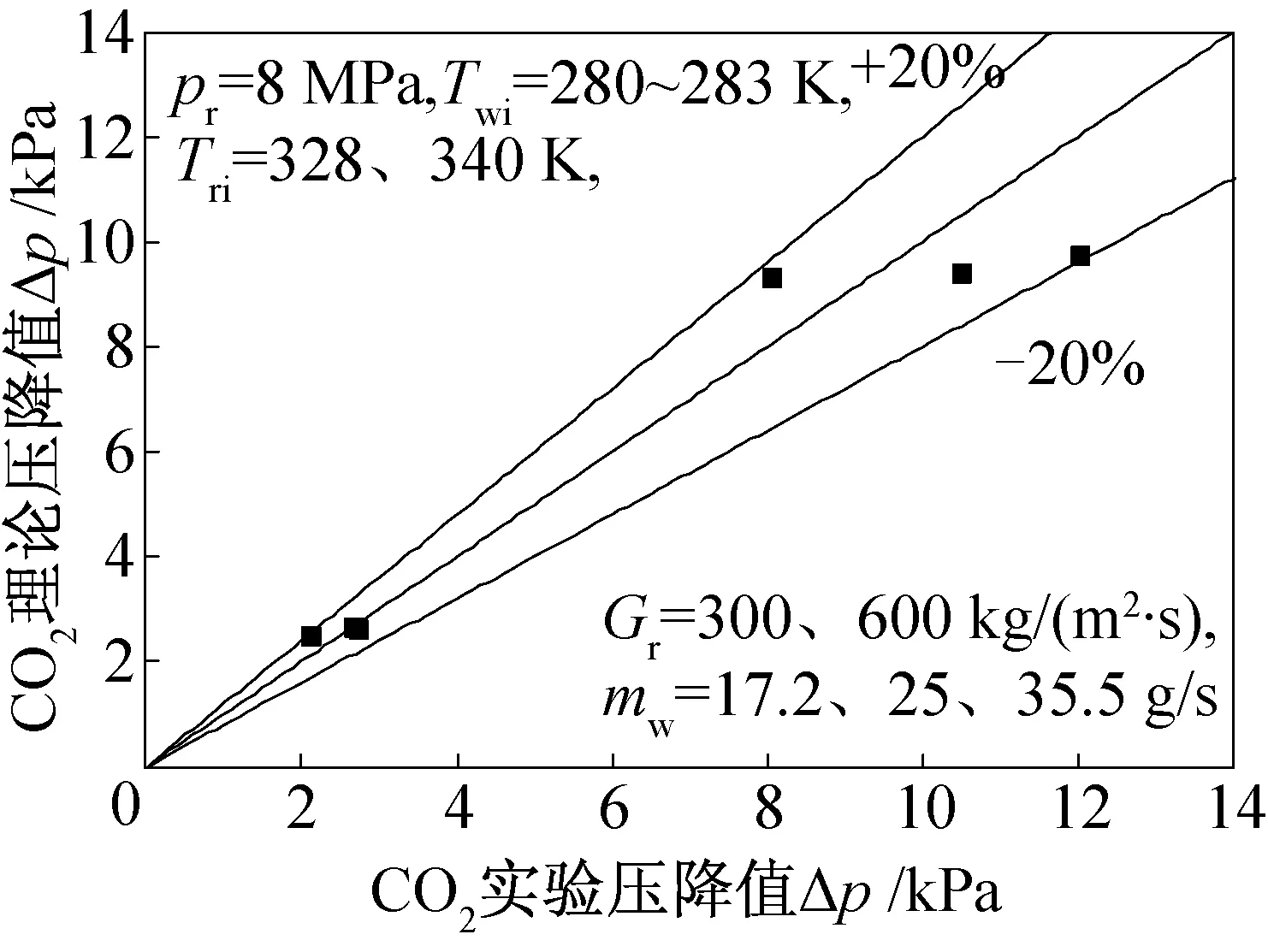跨临界CO2气冷器耗散分析
2015-06-15石冬冬马逸平陈文景
石冬冬 吕 静 曹 科 马逸平 陈文景 李 昶
(上海理工大学环境与建筑学院 上海 200093)

石冬冬 吕 静 曹 科 马逸平 陈文景 李 昶
(上海理工大学环境与建筑学院 上海 200093)




1 数学模型

以文献[12]中的CO2套管式气冷器为研究对象,如图1所示,管内侧为跨临界CO2制冷剂,管外侧为冷却水,该气冷器采用逆流的方式进行热交换。

图1 CO2气冷器示意图Fig.1 Schematic diagram of CO2 gas cooler

(1)
当定压比热为常数时,由式(1)可得:
(2)
图2所示为CO2在跨临界区不同压力下定压比热随温度变化曲线。由图2可知,当压力一定时,CO2定压比热为温度的函数,在临界点附近达到最大值;当状态点远离临界点时,其定压比热逐渐减小;在高温段,CO2压力越大,定压比热越大。

图2 不同压力下CO2定压比热曲线图Fig.2 The specific heat graphical chart of carbon dioxide at different pressure


(3)
化简后得式(4):

(4)

图3 CO2气冷器微元划分示意图Fig.3 Infinitesimal division diagram of CO2 gas cooler
整个换热过程中,在临界点附近,CO2定压比热随温度变化而大幅度变化,为提高计算准确性,沿水流动方向将气冷器分为等长度的N个微元,如图3所示。对于各个微元段,以CO2入口温度及压力来确定其所在微元段的各物性参数,以该微元段的换热量及CO2进出口温度差确定CO2的平均热容流量。由此可得:

(5)

(6)


(7)

(8)


(9)

(10)
ΔE*=(ΔE*)T+(ΔE*)p=(ΔEr*)T+(ΔEw*)T+(ΔE*)p

(11)
在换热器设计时,一般冷热流体的入口工况已知,未知参数为各微元段CO2与水进出口温度Tri,j、Tro,j、Twi,j、Two,j、CO2压降Δpr,j,以及气冷器CO2与水出口温度Tro、Two。
1.2 气冷器传热分析
为了简化计算模型,对每个微元段做如下假设:1)管子沿轴方向不存在热传导;2)忽略热损失;3)忽略微元段CO2侧压降对物性参数的影响;4)CO2与水侧均为一维稳态流动;5)忽略污垢形成的热阻。
以j微元段为例,该微元段可视为一个小的逆流换热器,建立热平衡方程,采用ε-NTU方法,计算得出该微元段CO2与水的出口温度。
1)水侧热平衡方程:
Qw,j=mwcpw(Two,j-Twi,j)
(12)
2)CO2侧热平衡方程:
(13)
3)ε-NTU方法:
Qj=εjCmin,j(Tri,j-Twi,j)
(14)
对于逆流换热器,效能系数[14]的表达式为:
(15)

CO2侧与水侧的整体传热系数定义如下:
(16)
CO2侧对流换热系数采用Gnielinski V[15]提出的传热关联式计算:
(17)

当Re<2300时,水侧对流换热系数采用Sieder-Tate[16]公式来计算:
(18)
此公式的定性温度为流体的平均温度,ηp为按照壁面温度计算得到的动力粘滞系数。
当Re≥2300时,水侧对流换热系数采用Dittus-Boelter[17]传热关联式计算:
Nuw=0.023Rew0.8Prw0.4
(19)
1.3 气冷器压降分析
该气冷器为平行流换热器,其静压损失为0,总压降由摩擦压降、加速压降与局部阻力压降组成。以j微元段为例,计算该微元段总压降。
1)CO2侧摩擦压降由式(20)计算:
(20)
f为摩擦因子,采用Churchill关联式[18]:

(21)
绝对粗糙度ψ取典型值5 μm。
2)CO2侧加速压降[12]由式(22)计算:
(22)
3)CO2侧局部阻力压降[12]由式(23)计算:
(23)
1.4 仿真计算


图4 CO2气冷器耗散计算仿真流程Fig.4 Simulation process of CO2 gas cooler entransy dissipation
2 结果与讨论
2.1 模型验证


表1 文献[12]实验管型尺寸Tab.1 Geometrical dimensions of test tube[12]

(24)

图5 CO2与水温度沿程分布的实验值与模拟值比较Fig.5 Comparisons of experimental and numerical simulation value of CO2 and water temperature distribution

图6 CO2侧压降实验值与模拟值比较Fig.6 Comparisons of experimental and numerical simulation value of CO2 pressure drop
2.2 算例分析





(25)


(26)

图7 当pr=9 MPa、mw=30 g/s、Tri=363 K、Twi=283 K时, 跨临界CO2气冷器耗散产生因素分析Fig.7 Analysis of transcritical CO2 gas cooler entransy dissipation generating factors when pr=9 MPa, mw=30 g/s, Tri=363 K,Twi=283 K


图8 当pr=11 MPa、Gr=300 kg/(m2·s)、mw=30 g/s、 Tri=363 K、Twi=283 K时,微元段耗散数分布Fig.8 Entransy dissipation number distribution of each infinitesimal segment when pr=11 MPa, Gr=300 kg/(m2·s),mw=30 g/s, Tri=363 K, Twi=283 K



图9 当pr=9 MPa、Tri=363 K、Twi=283 K时, CO2质量流率Gr、水质量流量mw对系统耗散数的影响Fig.9 The influence of CO2 and water mass flow rate on system entransy dissipation number when pr=9 MPa, Tri=363 K, Twi=283 K



图10 当Gr=300 kg/(m2·s)、Tri=363 K、Twi=283 K时, CO2进口压力pr对系统耗散数的影响Fig.10 The influence of CO2 inlet pressure on system entransy dissipation number when Gr=300kg/(m2·s), Tri=363 K, Twi=283 K


图11 当Gr=300 kg/(m2·s)、pr=9 MPa、Twi=283 K时, CO2进口温度对系统耗散数的影响Fig.11 The influence of CO2 inlet temperature on system entransy dissipation number when Gr=300 kg/(m2·s), pr=9 MPa, Twi=283 K



图12 当mw=30 g/s、pr=9 MPa、 Tri=363 K时水进口温度对系统耗散数的影响Fig.12 The influence of water inlet temperature on system entransy dissipation number when mw=30 g/s, pr=9 MPa, Tri=363 K
3 结论





5)在确定热力参数优化匹配时,应同时从CO2与水两侧入手,综合考虑各参数间的相互影响,以达到更好的节能目的。
本文受上海理工大学教育教学改革研究资助项目(2015-JPBKZ-005)和沪江基金资助项目(D14003)资助。(The project was supported by the Education Reform Project of USST(No.2015-JPBKZ-005) and the Hujiang Foundation of China(No.D14003).)
符号说明
A——传热面积,m2
cp——比热容,J/(kg·K)
d——管径,m

G——质量流率,kg/(m2·s)
h——焓值,kJ/kg
l——微元段长度,m
T——开尔文温度,K
m——质量流量,kg/s
NTU——传热单元数
p——压力,MPa
Pr——普朗克数
Re——雷诺数
Q——换热量,W
Qvh——热容量,W
T——温度,K
U——总换热系数,W/(m2·K)


ε——效能系数
λ——导热系数,W/(m2·K)
η——动力粘滞系数,Pa·s
ζ——局部阻力系数
下标
i——进口
j——流程数
o——出口
r——CO2
w——水
[1] Bejan A. Entropy generation through heat and fluid flow[M]. New York: Wiley, 1982.
[2] Bejan A. Advanced engineering thermodynamics[M]. New York: Wiley, 1988.
[3] Hesselgreaves J E. Rationalisation of second law analysis of heat exchangers[J]. International Journal of Heat & Mass Transfer, 2000, 43(22):4189-4204.

[5] 过增元, 程新广, 夏再忠. 最小热量传递势容耗散原理及其在导热优化中的应用[J]. 科学通报, 2003, 48(1): 21-25. (Guo Zengyuan, Cheng Xinguang, Xia Zaizhong. The principle of the minimum heat transfer potential capacity and its application in the optimization of heat conduction[J]. Chinese Science Bulletin, 2003, 48(1): 21-25.)
[7] 李志信, 过增元. 对流传热优化的场协同理论[M]. 北京: 科学出版社, 2010.




[12] 吕静. 二氧化碳跨临界循环及换热特性的研究[D]. 天津: 天津大学, 2005.

[14] 连之伟. 热值交换原理与设备[M]. 2版. 北京: 中国建筑工业出版社, 2006: 194-196.
[15] Gnielinski V. New equations for heat and mass transfer in turbulent pipe and channel flows[J]. International Chemical Engineering, 1976, 16(2): 359-368.
[16] 杨世明, 陶文铨. 传热学[M]. 4版. 北京: 高等教育出版社, 2007: 250-252.
[17] 黄冬平, 梁贞潜, 丁国良, 等. 基于模型的二氧化碳微通道气体冷却器性能分析[J]. 化工学报, 2002, 53(8): 832-836. (Huang Dongping, Liang Zhenqian, Ding Guoliang, et al. Modeling and performance analysis of carbon dioxide micro-channel gas cooler [J]. CIESC Journal, 2002, 53(8): 832-836.)
[18] 金纪峰. 采用微通道换热器的二氧化碳汽车空调系统研究[D]. 上海: 上海交通大学, 2010.
About the corresponding author
Lü Jing, female, doctor candidate, associate professor, School of Environment and Architecture, University of Shanghai for Science and Technology, +86 21-55270275, E-mail: Lvjing810@163.com. Research fields: heat transfer characteristics of supercritical carbon dioxide.
Entransy Dissipation Analyses of Transcritical CO2Gas Cooler
Shi Dongdong Lü Jing Cao Ke Ma Yiping Chen Wenjing Li Chang
(School of Environment and Architecture, University of Shanghai for Science and Technology, Shanghai, 200093, China)
Transcritical CO2system has become a hot topic in the field of heat pumps and air conditioning. In this paper, the CO2gas cooler was taken as a research subject. The system entransy dissipation was produced by the temperature difference of heat transfer and flow resistance of inside and outside fluid. A steady state distributed parameter model for the transcritical region of CO2gas cooler was established to solve entransy dissipation numberΔE*. The main reason of entransy dissipation number generation and its distribution were analyzed. Meanwhile, the effects of CO2and entrance parameters of water on the system entransy dissipation number were discussed. Results from the mathematic model showed that system entransy dissipation was mainly caused by temperature difference of heat transfer. The more the temperature difference, the bigger the entransy dissipation number. In each infinitesimal segment, the entransy dissipation number and the magnitude of CO2temperature dropwere in an inverse relationship. At the critical point, ΔEj*reached a maximum value. With the increase of mass flow rate and inlet pressure of CO2, the system entransy dissipation number became lager. While with the increase of water mass flow rate, the system entransy dissipation number decreased. Meanwhile, the higher the pressure, the smaller the decreased magnitude of entransy dissipation number. With the increasing of CO2inlet temperature, the entransy dissipation number decreased. The decreased degree of entransy dissipation number goes down with the increase of CO2inlet temperature. In addition, the inlet temperature of water has little impact on system entransy dissipation number.
gas cooler;transcritical cycle;entransy dissipation number;numerical simulation;carbon dioxide
2015年5月26日
0253- 4339(2015) 06- 0090- 08
10.3969/j.issn.0253- 4339.2015.06.090
TB61+1;TQ051.5
A
吕静,女,博士研究生,副教授,上海理工大学环境与建筑学院,(021)55270275,E-mail:Lvjing810@163.com。研究方向:超临界二氧化碳传热特性的研究。
